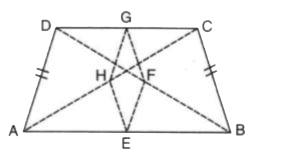ABCD is a square. P, Q and Rare the points on AB, BC and CD respectively, such that AP = BQ = CR. Prove that:
PB = QC
To prove that PB=QC given that ABCD is a square and AP=BQ=CR, we can follow these steps:
1. Draw the Square and Label Points:
- Draw square ABCD with points P, Q, and R on sides AB, BC, and CD respectively.
- Label the vertices: A at the top left, B at the top right, C at the bottom right, and D at the bottom left.
2. Identify Given Information:
- We are given that AP=BQ=CR=x (let's denote this common length as x).
3. Express Lengths of Sides:
- Since ABCD is a square, all sides are equal. Let the length of each side be s.
- Therefore, we can express the lengths as:
- AB=AP+PB
- BC=BQ+QC
4. Set Up the Equations:
- From the above expressions, we have:
- AB=AP+PB → s=x+PB
- BC=BQ+QC → s=x+QC
5. Equate the Two Expressions for s:
- Since both expressions equal s, we can set them equal to each other:
x+PB=x+QC
6. Simplify the Equation:
- Subtract x from both sides:
PB=QC
7. Conclusion:
- We have shown that PB=QC, which is what we needed to prove.
Final Statement:
Thus, we conclude that PB=QC. Hence proved.
---
- Draw square ABCD with points P, Q, and R on sides AB, BC, and CD respectively.
- Label the vertices: A at the top left, B at the top right, C at the bottom right, and D at the bottom left.
- We are given that AP=BQ=CR=x (let's denote this common length as x).
- Since ABCD is a square, all sides are equal. Let the length of each side be s.
- Therefore, we can express the lengths as:
- AB=AP+PB
- BC=BQ+QC
- From the above expressions, we have:
- AB=AP+PB → s=x+PB
- BC=BQ+QC → s=x+QC
- Since both expressions equal s, we can set them equal to each other:
x+PB=x+QC
- Subtract x from both sides:
PB=QC
- We have shown that PB=QC, which is what we needed to prove.
Thus, we conclude that PB=QC. Hence proved.
Topper's Solved these Questions
- CHAPTERWISE REVISION (STAGE 3) BOOK - ICSECHAPTER - CHAPTERWISE REVISION (STAGE 3) EXERCISE - ISOSCELES TRIANGLES
2 Videos
- CHAPTERWISE REVISION (STAGE 3) BOOK - ICSECHAPTER - CHAPTERWISE REVISION (STAGE 3) EXERCISE - INEQUALITIES
7 Videos
- CHAPTERWISE REVISION (STAGE 3) BOOK - ICSECHAPTER - CHAPTERWISE REVISION (STAGE 3) EXERCISE - LOGARITHM
9 Videos
- CHAPTERWISE REVISION (STAGE 1) BOOK - ICSECHAPTER - CHAPTERWISE REVISION (STAGE 1) EXERCISE - Graphical solution
10 Videos
- CIRCLEBOOK - ICSECHAPTER - CIRCLEEXERCISE - EXERCISE 17(D)
12 Videos
Similar Questions
ABCD is a square. P, Q and Rare the points on AB, BC and CD respectively, such that AP = BQ = CR. Prove that:
PQ = QR
View SolutionABCD is a square. P, Q and Rare the points on AB, BC and CD respectively, such that AP = BQ = CR. Prove that:
If angle PQR is a rt. Angle find angle PRQ
View SolutionABCD is a square, X and Y are points on sides AD and BC respectively such that AY=BX. Prove that BY=AX and ∠BAY=∠ABX.
View SolutionIn the adjoining figure, ABCD is a quadrilateral. M and N are the points on AD and CD respectively such that AB=BC,∠ABM=∠CBN and ∠MBD=∠NBD. Prove that BM=BN.

View SolutionABCD is a rectangle measuring 60 cm by 50 cm P,Q,and R are the points on AB, AD , and BC, respectively, such that AP=40cm,AQ=20cm,andBR=40cm. Find the area of the polygon QPBCD.
View SolutionABCD is a quadrilateral in which AD = BC. E, F, G and H are the mid-points of AB, BD, CD and AC respectively. Prove that EFGH is a rhombus.

View SolutionABCD is a parallelogram. Two points P and Q are taken on sides AD and BC respectively such that AP 13ADandCQ=13BC. Prove that □AQCP is a parallelogram.
View SolutionA (2, 5), B (-1, 2) and C (5, 8) are the co-ordinates of the vertices of the triangle ABC. Points P and Q lie on AB and AC respectively, such that : AP: PB = AQ: QC = 1:2.
Show that : PQ=13BC.
View SolutionP,Q,R are the points on the sides AB, BC and CA respectively of triangle ABC such that AP:PB=BQ:QC=AR:RC=1:2. Show that PBQR is a parallelogram.
View SolutionABCD is a trapezium in which AB||DC and P,Q are points on AD and BC respectively, such that PQ||DC, if PD=18 cm, BQ=35 cm and QC=15 cm. Find AD.
View Solution
